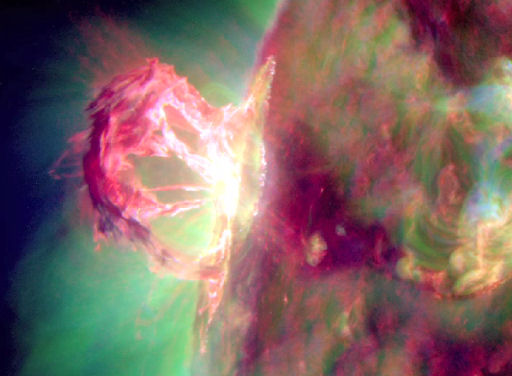Sunstorm? Been There, Done That
Solar tantrums of 1859, 1921, and 1989
Despite being the strongest solar storm since 2005, this week’s flareup appears to have caused few disruptions on Earth. (As Space.com reports, the Coronal Mass Ejection “hit Earth at an angle, so the electromagnetic burst was largely shielded by the planet’s magnetic field.”)
But the storm did lead some airlines—including Delta, Qantas, and Air Canada—to alter their transpolar routes to reduce potential disruptions to high-frequency radio communication along the way. At least one Qantas flight, reports AvWeb, carried an extra five tons of fuel in order to fly a less southerly route.
We may have gotten off easy. The remarkable electrical effects of solar storms have been recorded in newspapers since British astronomer Richard Carrington noticed a solar eruption in 1859 while sketching sun spots seen through his telescope. Just days later, the northern lights—seen as far south as Cuba—damaged telegraph systems, even setting offices on fire and melting wires. On August 30, 1859, the New York Times included this observation from the superintendent of the Canadian Telegraph Company:
I never, in my experience of fifteen years in the working of telegraph lines, witnessed anything like the extraordinary effect of the Aurora Borealis, between Quebec and Further Point last night. The line was in most perfect order, and well-skilled operators worked incessantly from 8 o’clock last evening till 1 o’clock this morning, to get over in even a tolerably intelligent form about four hundred words of the steamer Indian‘s report for the Associated Press, and at the latter hour so completely were the wires under the influence of the Aurora Borealis, it was found utterly impossible to communicate between the telegraph stations, and the line was closed for the night.
Another solar storm, nearly as strong as what has come to be known as the Carrington event, occurred in 1921. On May 16, 1921, the Los Angeles Times reported that “electrical influences exerted by the Aurora Borealis…continued today to play havoc with telegraph traffic throughout the United States…. For more than an hour before midnight Saturday nearly every telephone wire leading from New York and Chicago was out of condition.”
The New-York Tribune hoped to calm its readers by noting that the sun would soon “turn spotted face away and end earthly wire troubles,” while the New York Times reported disturbances in France: “The operators at the central transmission stations came to the conclusion that a strange force had got into their instruments, for nothing would go right. Morse instruments, instead of making dots and dashes, recorded one long line. Hughes instruments produced words in what might have been an unknown language, and Baudot, of which French telegraphers are proud because it is very intricate, seemed possessed by evil spirits.”
Newcomb Carlton, president of the Western Union Telegraph Company, was quoted in the New York Times as saying: “The magnetic disturbances were much the worst ever experienced. A great many fuses were blown out on our land lines and we had great difficulty with the submarine cables.” The story also reports that the solar storm burned out a telephone station in Sweden, which then contributed to a short circuit in the New York Central signal system, which was followed by a fire in the Fifty-seventh Street signal tower.
In 1989, the Washington Post reported on December 18 that a solar storm—or “titanic temper tantrum”—set off radiation alarms aboard the supersonic Concorde in flight, damaged orbiting satellites, and caused a nine-hour power blackout in most of Canada’s Quebec province.
In comparison, Space.com reports, this week’s solar flare caused “minor disruptions to spacecraft and power grids.”
